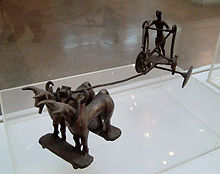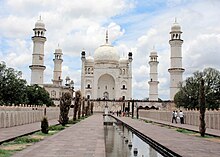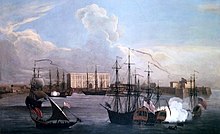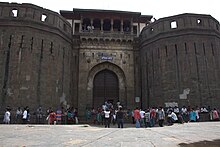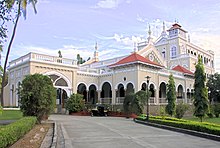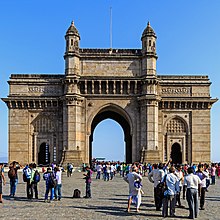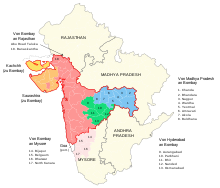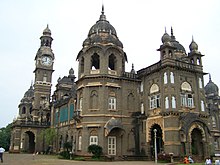History of Maharashtra
At the time of the Indian independence movement in the early 20th century, the region—along with the British-ruled areas of Bombay Presidency, and Central Provinces and Berar—included many British vassal states.
The oldest stone inscriptions in the Marathi language date to around 975 CE,[1] and can be seen at the foot of the Lord Bahubali statue in the Jain temple at Shravanabelgola in modern-day Karnataka.
[2][3] The largest settlement discovered of the culture is at Daimabad, a Late Harappan site, which had a mud fortification during this period, as well as an elliptical temple with fire pits.
It is unclear where his capital was located; some argue that it was Shrinagara, while an early inscription suggests it was Chandradityapura (modern Chandwad in the Nasik district).
[30] According to scholars such as George M. Moraes,[31] V. K. Rajwade, C. V. Vaidya, A.S. Altekar, D. R. Bhandarkar, and J. Duncan M. Derrett,[32] the Seuna rulers were of Maratha descent.
[34] The early period of Islamic rule saw atrocities such as imposition of Jizya tax on non-Muslims, temple destruction, and forcible conversions.[how?
A number of families such as Shinde, Bhosale, Shirke, Ghorpade, Jadhav, More, Mahadik, Ghatge, and Nimbalkar loyally served different sultans at different periods in time.
During the reign of Aurangzeb, Gond king Bakht Buland Shah accepted Islam and founded the present-day city of Nagpur.
Centuries earlier, Khandkya Ballal Sah, a 13th-century Gond king, founded the walled city of Chandrapur in southern Vidarbha region.
The Marathas also expanded further south into Southern India, defeating the independent local rulers there and capturing Jinji in Tamil Nadu.
For his campaigns in North India, he actively promoted young leaders of his own age such as Ranoji Shinde, Malharrao Holkar, the Puar brothers, and Pilaji Gaekwad.
[68][69] At its peak, the empire stretched from Tamil Nadu[70] in the south, to Peshawar (modern-day Khyber Pakhtunkhwa, Pakistan[71][note 1]) in the north, and Bengal in the east.
In 1775, the East India Company intervened in a Peshwa family succession struggle in Pune, leading to the First Anglo-Maratha War, which resulted in a Maratha victory.
In the early part of the 1700s, under the leadership of Kanhoji Angre, this navy dominated the territorial waters of the western coast of India from Bilimora[75] to Savantwadi.
A significant state that paid chauth at times but was also in constant conflict with the Marathas was the Asaf Jahi dynasty, alternatively known as the Nizam of Hyderabad.
The Nizam ruled the Marathwada region of present-day Maharashtra as well as Telangana and parts of Karnataka during the 18th century, and later as a vassal of the British until the Indian independence.
[84] Although the majority of the population in Maharashtra has lived in rural areas throughout history, cities and towns were founded or expanded when new rulers chose new capitals.
[107] People from Maharashtra played an important part in the nationalist, social, and religious reform movements of the late 19th and early 20th centuries.
The Sarvajanik Sabha took an active part in relief efforts during the famine of 1875–76, and is considered the forerunner of the Indian National Congress established in 1885.
[108][109] The most prominent personalities of Indian Nationalism in the late 19th and early 20th century were Gopal Krishna Gokhale and Bal Gangadhar Tilak, who were on opposite sides of the political spectrum and both from Pune.
Raosaheb and Achutrao Patwardhan, Nanasaheb Gore, Shreedhar Mahadev Joshi, Yeshwantrao Chavan, Swami Ramanand Bharti, Nana Patil, Dhulappa Navale, V.S.
Page, Vasant Patil, Dhondiram Mali, Aruna Asif Ali, Ashfaqulla Khan, and several other leaders from Maharashtra played a prominent role in this struggle.
Joshi, Shripad Amrit Dange, Pralhad Keshav Atre, and Gopalrao Khedkar were prominent activists in the campaign to create a separate state of Maharashtra with Mumbai as its capital.
[125] In 1956, some Marathi-majority talukas were also transferred to the Adilabad, Medak, Nizamabad, and Mahaboobnagar districts of the new Telugu State (now Telangana), to the east of Maharashtra.
The Shiv Sena party was formed in the 1960s by Balashaheb Thackerey, a cartoonist and journalist, to advocate and agitate for the interests of Marathi people in Mumbai.
Raj Thackeray, like his uncle, also tried to win support from the Marathi community by whipping up anti-immigrant sentiment in Maharashtra, for instance against Biharis and other north Indians.
The late 1990s and first decade of the 21st century saw huge development in the information technology sector, and IT Parks were set up in the Aundh and Hinjewadi areas of Pune.
The relief measures undertaken by the Government of Maharashtra included employment, programmes aimed at creating productive assets such as tree plantation, conservation of soil, excavation of canals, and building artificial lentic water bodies.
The relief works initiated by the state government helped employ over 5 million people at the height of the drought, leading to effective famine prevention.
[164] The effectiveness was also attributed to the direct pressure on the state government by the public, who perceived that employment via the relief works programme was their right.
